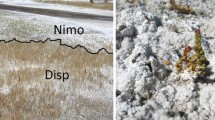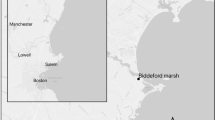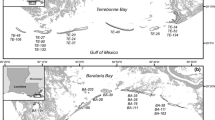Summary
Tidal flooding is widely believed to be an important determinant of marsh plant distributions but has rarely been tested in the field. In New England the marsh elder Iva frutescens often dominates the terrestrial border of salt marshes and we examined its flood tolerance and distribution patterns. Marsh elders only occur at elevations where their roots are not subject to prolonged water table flooding. Consequently they are found on the terrestrial border of marshes and at lower elevations associated with drainage ditches and locally elevated surfaces. Marsh elders transplanted to elevations lower than they normally occur died within a year with or without neighbors and greenhouse tests revealed that I. frutescens is much less tolerant of flooded soil conditions than plants found at lower marsh elevations. We also manipulated the water table level of field plots and found that increasing or decreasing water table drainage led to enhanced and diminished I. frutescens performance, respectively. Our results demonstrate the importance of water table dynamics in generating spatial patterns in marsh plant communities and provide further evidence that supports the hypothesis that the seaward distributional limits of marsh plant populations are generally dictated by physical processes.
Similar content being viewed by others
References
Armstrong W (1970) Rhizosphere oxidation in rice and other species: a mathematical model based on the oxygen flux component. Plant Physiology 23:623–630
Armstrong W (1975) Waterlogged soils. In: Etherington JR (ed) Environment and plant ecology. John Wiley, New York, pp. 181–218
Bertness MD (1991a) Zonation of Spartina spp. in a New England salt marsh. Ecology 72(1):138–148
Bertness MD (1991b) Interspecific interactions among high marsh perennials in a New England salt marsh. Ecology 72:125–137
Bertness MD and Ellison AM (1987) Determinants of pattern in a New England salt marsh plant community. Ecological Monographys 57(2):129–147
Chapman VJ (1974) Salt marshes and salt deserts of the world. J Cramer, Lehre
Connell JH (1972) Community interactions on marine rocky intertidal shores. Annual Review of Ecology and Systematics 3:169–192
Gleason ML (1980) Influence of tidal inundation on internal oxygen supply of Spartina alterniflora and Spartina patens. Dissertation, University of Virginia
Johnson DS, York HH (1915) The relation of plants to tidal levels. Carnegie Institute. Washington, DC, Publ. 206
King GM, Klug MJ, Wiegert RG, Chalmers AG (1982) Relation of soil water movement and sulfide concentration to Spartina alterniflora production in a Georgia salt marsh. Science 218:61–63
Kozlowski TT (1984) Flooding and plant growth. Academic Press, New York
Lesser CR (1975) Some effects of grid systems mosquito control ditching on salt marsh biota in Delaware. Master's thesis, University of Delaware, 24 p
Mendelssohn IA, McKee KL, Patrick WH (1981) Oxygen deficiency in Spartina alterniflora roots: metabolic adaptation to anoxia. Science 214:439–441
Miller WB, Egler FE (1950) Vegetation of the Wequetequock-Pawcatuck tidal marshes, Connecticut. Ecological Monographs 20:143–172
Nixon SW (1982) The ecology of New England high salt marshes: a community profile. U.S. Department of the Interior, Washington DC
Pennings S, Callaway R (1992) Salt marsh zonation: the relative improtance of competition and physical factors. Ecology: 73(2):681–690
Snow A, Vince S (1984) Plant zonation in an Alaskan salt marsh. II. An experimental study of the role of edaphic conditions. Journal of Ecology 72:669–684
Teal JM, Kanwisher JW (1966) Gas transport in the marsh grass, Spartina alterniflora. J Exp Botany 17:355–361
Wiegert RG, Chalmers AG, Randerson PF (1983) Productivity gradients in salt marshes: the response of Spartina alterniflora to experimentally manipulated soil water movement. Oikos 41:1–6
Zedler JB (1982) The Ecology of Southern California Coastal Salt Marshes. US Department of Interior FWS-OBS-81-54
Author information
Authors and Affiliations
Rights and permissions
About this article
Cite this article
Bertness, M.D., Wikler, K. & Chatkupt, T. Flood tolerance and the distribution of Iva frutescens across New England salt marshes. Oecologia 91, 171–178 (1992). https://doi.org/10.1007/BF00317780
Received:
Accepted:
Issue Date:
DOI: https://doi.org/10.1007/BF00317780




